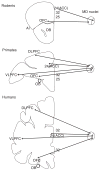Converging models of schizophrenia--Network alterations of prefrontal cortex underlying cognitive impairments
- PMID: 26408506
- PMCID: PMC4656070
- DOI: 10.1016/j.pneurobio.2015.09.010
Converging models of schizophrenia--Network alterations of prefrontal cortex underlying cognitive impairments
Abstract
The prefrontal cortex (PFC) and its connections with other brain areas are crucial for cognitive function. Cognitive impairments are one of the core symptoms associated with schizophrenia, and manifest even before the onset of the disorder. Altered neural networks involving PFC contribute to cognitive impairments in schizophrenia. Both genetic and environmental risk factors affect the development of the local circuitry within PFC as well as development of broader brain networks, and make the system vulnerable to further insults during adolescence, leading to the onset of the disorder in young adulthood. Since spared cognitive functions correlate with functional outcome and prognosis, a better understanding of the mechanisms underlying cognitive impairments will have important implications for novel therapeutics for schizophrenia focusing on cognitive functions. Multidisciplinary approaches, from basic neuroscience to clinical studies, are required to link molecules, circuitry, networks, and behavioral phenotypes. Close interactions among such fields by sharing a common language on connectomes, behavioral readouts, and other concepts are crucial for this goal.
Keywords: Brain imaging; Circuitry formation; Circuitry maturation; Cognitive function; Networks; Oscillation; Prefrontal cortex.
Copyright © 2015 Elsevier Ltd. All rights reserved.
Figures




Similar articles
-
Cognitive control deficits in schizophrenia: mechanisms and meaning.Neuropsychopharmacology. 2011 Jan;36(1):316-38. doi: 10.1038/npp.2010.156. Epub 2010 Sep 15. Neuropsychopharmacology. 2011. PMID: 20844478 Free PMC article. Review.
-
Neural circuits subserving behavioral flexibility and their relevance to schizophrenia.Behav Brain Res. 2009 Dec 7;204(2):396-409. doi: 10.1016/j.bbr.2008.12.001. Epub 2008 Dec 6. Behav Brain Res. 2009. PMID: 19110006 Review.
-
Evaluation of the efficacy of transcranial direct current stimulation in the treatment of cognitive symptomatology in the early stages of psychosis: study protocol for a double-blind randomized controlled trial.Trials. 2019 Apr 5;20(1):199. doi: 10.1186/s13063-019-3288-5. Trials. 2019. PMID: 30953544 Free PMC article.
-
Postnatal development of prefrontal inhibitory circuits and the pathophysiology of cognitive dysfunction in schizophrenia.Ann N Y Acad Sci. 2004 Jun;1021:64-76. doi: 10.1196/annals.1308.008. Ann N Y Acad Sci. 2004. PMID: 15251876 Review.
-
Disturbed Prefrontal Cortex Activity in the Absence of Schizophrenia-Like Behavioral Dysfunction in Arc/Arg3.1 Deficient Mice.J Neurosci. 2019 Oct 9;39(41):8149-8163. doi: 10.1523/JNEUROSCI.0623-19.2019. Epub 2019 Sep 5. J Neurosci. 2019. PMID: 31488612 Free PMC article.
Cited by
-
Static and temporal dynamic changes of intrinsic brain activity in early-onset and adult-onset schizophrenia: a fMRI study of interaction effects.Front Neurol. 2024 Nov 25;15:1445599. doi: 10.3389/fneur.2024.1445599. eCollection 2024. Front Neurol. 2024. PMID: 39655163 Free PMC article.
-
Stress Exposure in Dopamine D4 Receptor Knockout Mice Induces Schizophrenia-Like Behaviors via Disruption of GABAergic Transmission.Schizophr Bull. 2019 Sep 11;45(5):1012-1023. doi: 10.1093/schbul/sby163. Schizophr Bull. 2019. PMID: 30476265 Free PMC article.
-
Oscillatory Deficits in the Sub-Chronic PCP Rat Model for Schizophrenia Are Reversed by mGlu5 Receptor-Positive Allosteric Modulators VU0409551 and VU0360172.Cells. 2023 Mar 16;12(6):919. doi: 10.3390/cells12060919. Cells. 2023. PMID: 36980260 Free PMC article.
-
Neurobiology of emotional regulation in cyberbullying victims.Front Psychol. 2025 Mar 5;16:1473807. doi: 10.3389/fpsyg.2025.1473807. eCollection 2025. Front Psychol. 2025. PMID: 40110084 Free PMC article. No abstract available.
-
Effects of transcranial direct current stimulation on working memory and negative symptoms in schizophrenia: a phase II randomized sham-controlled trial.Schizophr Res Cogn. 2018 Feb 20;12:20-28. doi: 10.1016/j.scog.2018.02.003. eCollection 2018 Jun. Schizophr Res Cogn. 2018. PMID: 29552509 Free PMC article.
References
-
- Akbarian S, Bunney WE, Jr, Potkin SG, Wigal SB, Hagman JO, Sandman CA, Jones EG. Altered distribution of nicotinamide-adenine dinucleotide phosphate-diaphorase cells in frontal lobe of schizophrenics implies disturbances of cortical development. Arch Gen Psychiatry. 1993a;50:169–177. - PubMed
-
- Akbarian S, Kim JJ, Potkin SG, Hagman JO, Tafazzoli A, Bunney WE, Jr, Jones EG. Gene expression for glutamic acid decarboxylase is reduced without loss of neurons in prefrontal cortex of schizophrenics. Arch Gen Psychiatry. 1995;52:258–266. - PubMed
-
- Akbarian S, Vinuela A, Kim JJ, Potkin SG, Bunney WE, Jr, Jones EG. Distorted distribution of nicotinamide-adenine dinucleotide phosphate-diaphorase neurons in temporal lobe of schizophrenics implies anomalous cortical development. Arch Gen Psychiatry. 1993b;50:178–187. - PubMed
-
- Anderson G, Berk M, Dodd S, Bechter K, Altamura AC, Dell’osso B, Kanba S, Monji A, Fatemi SH, Buckley P, et al. Immuno-inflammatory, oxidative and nitrosative stress, and neuroprogressive pathways in the etiology, course and treatment of schizophrenia. Prog Neuropsychopharmacol Biol Psychiatry. 2013;42:1–4. - PubMed
Publication types
MeSH terms
Grants and funding
LinkOut - more resources
Full Text Sources
Other Literature Sources
Medical
Miscellaneous

